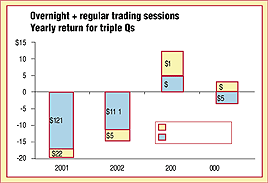Catch The Crest After The Close
Overnight Trading
by Anthony Trongone, Ph.D.
Trading that occurs after the regular trading session can dictate future action. Here's how you take advantage of this information.
Many readers wrote to me about my article in the January 2004 STOCKS & COMMODITIES. Since my findings were unsupportive of the earlier writings of some other "authorities," they were curious as to why such a phenomenon was unfolding. In this article, I'll begin by discussing possible causes responsible for or contributing to recent unorthodox pricing patterns that appear to contradict traditional expectations of technical analysis. I will then uncover some recent price anomalies that traders can use to their advantage.
It is not easy to take an antagonistic position against such a venerable lineup of technicians - especially one that throws cold water, at least temporarily, on the long-held theory that rising prices with rising volume (RPRV) is bullish and rising prices with falling (RPFV) volume is bearish. However, this traditional wisdom came long before the advent of the computer, direct-access trading, or widespread exposure to international trading.
And this is certainly a different era. The widespread availability of direct-access trading has given us a longer trading session, a smaller price range with which to trade, and the opportunity to take positions with no restrictive downtick rule (as with exchange-traded funds, or ETFs). These new developments are instrumental, but the most impressive departure from collective wisdom comes from the expanding role of trading in the overnight hours.
TRADING IN THE HOURS OF DARKNESS
Figure 1 shows the extent to which the overnight trading session, rather than the regular trading day, is dictating action. In 2003, the QQQs rose a sum of $12.09, of which $7.31 of the gain came after the close of trading. Apparently, these are active traders with a modified mindset, capable of generating a price change in a less active trading environment.
This pattern of strength is becoming more noticeable. In the previous 126 trading days starting from October 30, 2003, the profit in the overnight session was $6.57, overshadowing the negative performance (-$7.12) of the regular session.

FIGURE 1: PERFORMANCE DIFFERENCES. In 2003, 61% of the yearly dollar increase was in the overnight session. In the 83 trading days in 2004, the overnight session is positive, whereas the regular session was in negative territory.
...Continued in the July issue of Technical Analysis of
STOCKS & COMMODITIES
Excerpted from an article originally published in the July 2004 issue of Technical Analysis of STOCKS & COMMODITIES magazine. All rights reserved. © Copyright 2004, Technical Analysis, Inc.
Return to July 2004 Contents